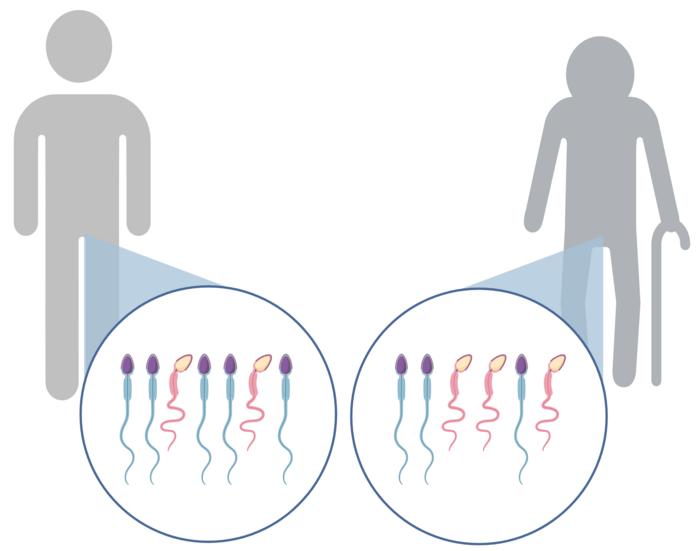A new paper in Genome Biology and Evolution, published by Oxford University Press, finds that the link between paternal age and rare congenital disorders is more complex than scientists had previously thought. While researchers have long realized that older fathers are more likely to have children with bone and heart malformations, such as Achondroplasia, Apert, or Noonan syndrome or neurodevelopmental disorders, schizophrenia, and autism, new examination indicates that while the link between some pathogenic mutations increases with paternal age, others do not and may even occur in the father’s testis before sexual maturity.

Credit: Irene Tiemann-Boege/ Genome Biology and Evolution
A new paper in Genome Biology and Evolution, published by Oxford University Press, finds that the link between paternal age and rare congenital disorders is more complex than scientists had previously thought. While researchers have long realized that older fathers are more likely to have children with bone and heart malformations, such as Achondroplasia, Apert, or Noonan syndrome or neurodevelopmental disorders, schizophrenia, and autism, new examination indicates that while the link between some pathogenic mutations increases with paternal age, others do not and may even occur in the father’s testis before sexual maturity.
Delayed fatherhood results in a higher risk of inheriting a new mutation that might result in a congenital disorder in the children. Fibroblast growth factor receptor 3 (FGFR3) is a protein in humans that is expressed in tissues including cartilage, and the brain, intestines, and kidneys.
Driver or selfish mutations, which can result in congenital disorders, are more common in the male germline, orders of magnitude higher than the estimated average human genome mutation rate per cell division per generation. These mutations are more common in the sperm of older men. Despite the importance of driver mutations in the male germline due to their high incidence and the increased frequency, as well as their potential pathogenic effects, researchers do not understand where the mutations really come from and why they are found so often. Do these mutations primarily propagate within the sexually mature germline, leading to an increased mutation burden in the population as men age? Or could driver mutations in sperm of young men already be much higher in numbers than assumed so far, with the risk of young dads having one or even more affected kids?
Researchers here collected sperm samples from anonymous doners at clinics in Austria and investigated the variant frequency for genetic mutations for ten different FGFR3 variants in men aged 23 to 59.
The investigators found that the FGFR3 variant associated with Achondroplasia, the most common form of short-limbed dwarfism, does increase with the father’s age. Another variant, this one associated with Thanatophoric dysplasia—a severe and usually fatal skeletal disorder in children characterized by a disproportionately small ribcage and extremely short limbs—also increased with paternal age. The researchers found that many other FGFR3 variants were unconnected to the father’s age. In particular, the variant associated with CATSHL (Camptodactyly-tall stature-scoliosis-hearing loss) syndrome was not more common in sperm of older men compared to younger men.
“Young dads also face a higher risk of having kids with pathogenic mutations, said the paper’s lead author, Irene Tiemann-Boege.
The paper, “Exploring FGFR3 mutations in the male germline: Implications for clonal germline expansions and parental age-related dysplasias,” is available (at midnight on February 27th) at https://academic.oup.com/gbe/article-lookup/doi/10.1093/gbe/evae015.
Direct correspondence to:
Irene Tiemann-Boege
Institute of Biophysics
Johannes Kepler University
Gruberstrasse 40
4020 Linz, AUSTRIA
[email protected]
To request a copy of the study, please contact:
Daniel Luzer
[email protected]
Journal
Genome Biology and Evolution
DOI
10.1093/gbe/evae015
Method of Research
Content analysis
Subject of Research
People
Article Title
Exploring FGFR3 mutations in the male germline: Implications for clonal germline expansions and parental age-related dysplasias
Article Publication Date
27-Feb-2024
COI Statement
N/A




